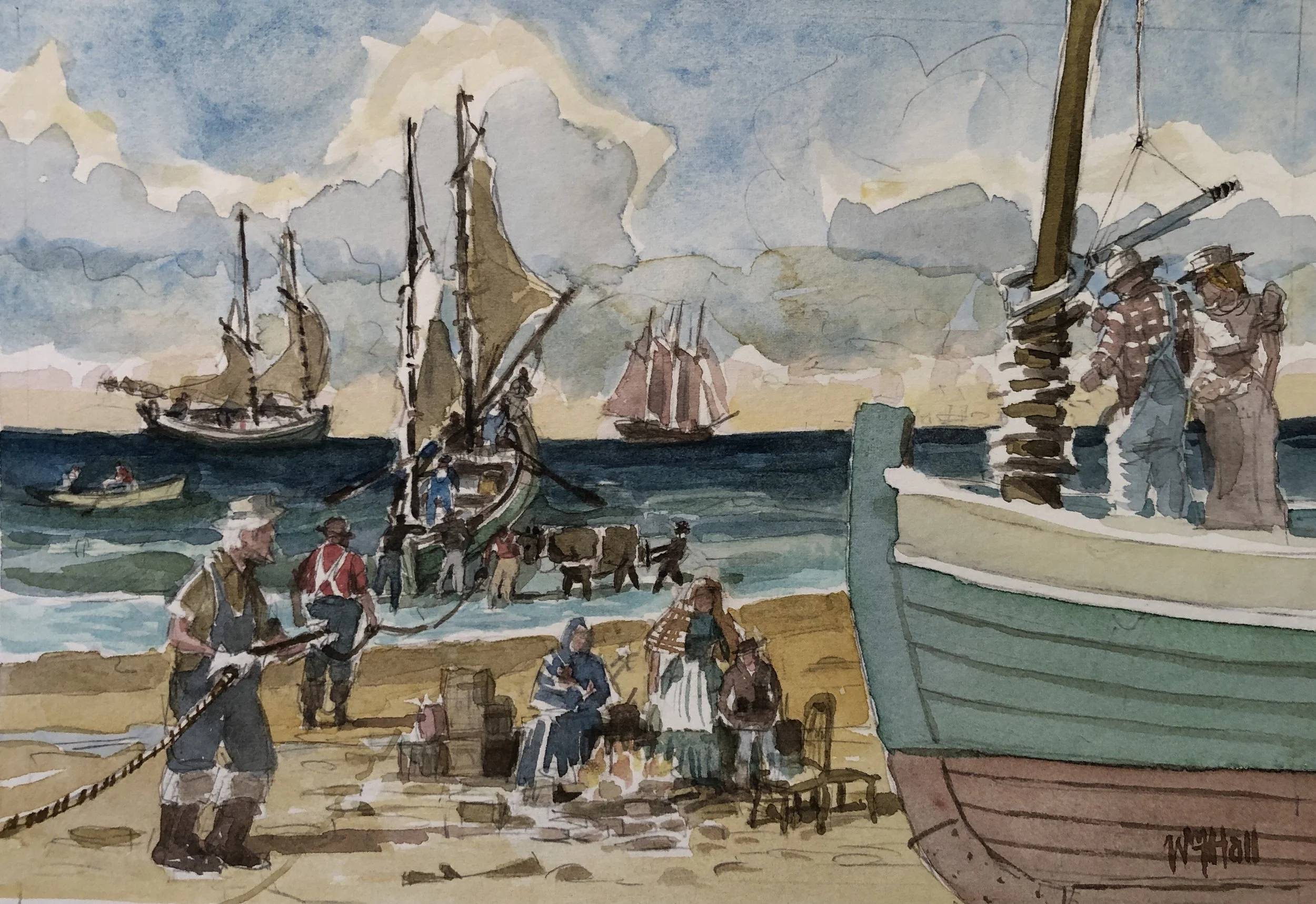
Times past on Block Island
“Gathering Seaweed (watercolor), in the show “Times Past: New Works by William Talmadge Hall,’’ at the Jessie Edwards Gallery, Block Island, through July 2.
He writes: “Seaweed from the beaches on Block Island was gathered as fertilizer and for food. The rule on Block Island in the 1800’s was that access to all beaches was protected for islanders to gather whatever they could find. This included seaweed, fish, salvage from shipwrecks, heating fuel, such as driftwood, and virtually anything else that would help them survive.’’
{Editor’s note: Seaweed aquaculture has been expanding at a good clip in New England in the past few years. Seaweed has many uses and growing it removes carbon dioxide from the atmosphere.}
The gallery says:
The show “displays the artist’s love of Block Island and history. These works are personal for Hall, a third-generation islander, and encompass a past he hopes that people think about as he immortalizes the rich and fabulous, and now too-often forgotten, history of the island’s people, land and sea in his beautiful watercolors.’’
“Fisherman’s Corner-Old Harbor Block Island’’
Mr. Hall explains:
“Once thick with fishing shacks, the west corner of Old Harbor was the domain of the Block Island fishing fleet. When the steamers on the Fall River Line docked on the east side of this harbor of refuge, the passengers from New York City, Providence, Boston and elsewhere in the region were delivered into a bustling port. But the hurricane of 1938 devastated this fleet; 80 percent of it was destroyed in a few hours. In its heyday, these docks landed enough fresh fish to meet a substantial part of the demands of urban centers in southern New England as well as of the summer resort season.’’
‘‘Victorian Swim Party” (1889)
“During the late Victorian era, which came to be called ‘The Gilded Age,’ Block Island became know as a tourist venue without the social restrictions imposed by, say, Newport high society. Large luxurious hotels offered a more open attitude to anyone, no matter who they were or where their money came from
“The beautiful and romantic scenery and relatively remote location encouraged discreet pleasure and relaxation.
“This painting evokes a slackening of Victorian dress codes and the pure pleasure
of being alive.’’
Handing down their boats and their livings
“Wedding Dowry” (watercolor on Arches Paper), by William Talmadge Hall, at David Chatowsky Art Gallery, 47 Dodge St., Block Island, R.I. (401) 835-4623
Hit this link for Mr. Hall’s Web site.
He explains:
“In this picture I show a Block Island Double-Ender fishing boat being brought up on the beach at the end of a day around 1840, with the help of oxen and block and tackle. The boats, a mainstay of the island’s fishing and transportation in the 18th and 19th centuries, were built by islanders to circumvent the problem of not having particularly safe harbors, necessitating that boats be drawn up into the dunes at night to wait for a favorable tide and reasonable weather.
This required the islanders to help each other daily, building a tight communal bond.
Fishing from the family-owned boats was so successful in harvesting the plentiful fish stocks around the island that the Block Island Double-Ender fleet grew large and the boats become famous for seaworthiness.
In this picture, the newlyweds on the boat to the right prepare to forge ahead in their new boat. Two generations of Block Islanders watch this ceremony as they sit on the beach at day’s end in front of a small fire.
Over the years, fathers handed down their boats to sons, and if there were no sons then a boat might be a dowry gift to a daughter and son-in-law.
The new husband brought the potential of a bigger extended fishing family once he had proven himself a worthy fisherman and become the the ascending key figure in the future.
Either way, the prize was the boat and the legacy it represented to a self-sufficient fishing community bolstered by shared beliefs.
xxx
I’m a 74-year-old artist. My family has been a part of Block Island's history for five generations. My father was the first male Hall on the island not to pursue fishing as a career, although he harpooned swordfish until he was drafted into the Army, in World War II.
I’m a watcher, and many of my paintings are about people working — the simple grace of people doing what they do each day to make a living. These folks don’t dwell much on the meaning or the ultimate results of what they do. They go with the flow of a continuum of work.
William Hall's maritime watercolors on the Block
“The A to Z, Lost in the 1938 Hurricane’ ‘ (watercolor on paper), by William Talmadge Hall. There will be a show of his new watercolors at the Jessie Edwards Studio, Block Island, R.I., Aug. 23-Sept. 4, wlth a reception Aug. 24, 5 to 7 p.m. The gallery is on Water Street, right across from the ferry landing.






